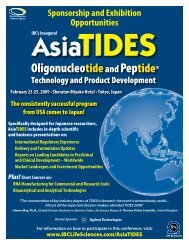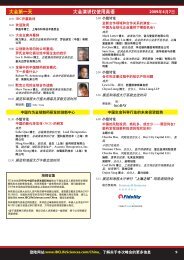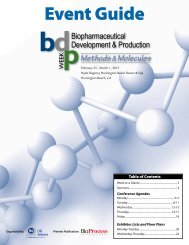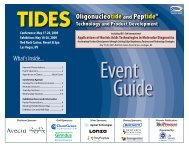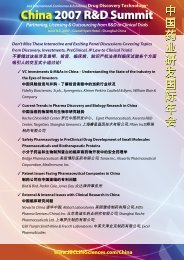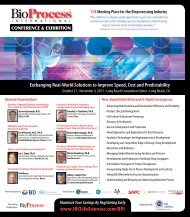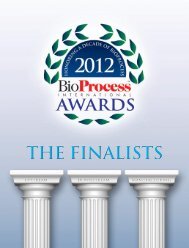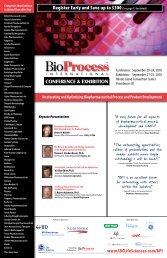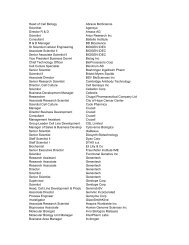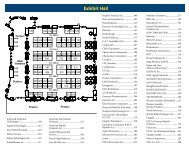Conference ⢠Tuesday, October 2, 2007 - IBC Life Sciences
Conference ⢠Tuesday, October 2, 2007 - IBC Life Sciences
Conference ⢠Tuesday, October 2, 2007 - IBC Life Sciences
Create successful ePaper yourself
Turn your PDF publications into a flip-book with our unique Google optimized e-Paper software.
Main <strong>Conference</strong> • Wednesday, <strong>October</strong> 3, <strong>2007</strong> (continued)12:00 Concurrent Technology WorkshopsCell Xpress Technology Facilitates High-Producing Chinese Hamster Ovary Cell LineGeneration Using Glutamine SynthetaseGene Expression SystemCell Xpress is a powerful alternative to traditionalclone selection approaches. It uses the LEAP(Laser-Enabled Analysis and Processing) technologyplatform to identify, purify and monitor expansion ofindividual clones that secrete monoclonal antibodies.This presentation focuses on using both Cell Xpressand media formulation screening to generate highproducingclones using the Lonza glutamine synthetase(GS) gene expression system.Genova A. Richardson, Research Scientist, Cell LineEngineering, SAFC BiosciencesPOROS® Chromatography Media:The Fix for Your DownstreamProcess BottleneckThe features and benefits of POROS® chromatographymedia as they relate to improving downstreampurification process productivity will be discussed.Performance benchmarking of the NEW MabCaptureA rPA affinity media and other POROS medias will behighlighted. Process productivity modeling will be usedto demonstrate the benefits of utilizing POROS mediafor purification unit operations.Christine Gebski, M.S., Applications Manager,Applied BiosystemsSequential Multi-ColumnChromatography – Enabling ContinuousDownstream ProcessingA unique approach to continuous chromatography,when applied to single unit process operations(SMCC) promises impressive gains in productivity.More significantly, as the solution to the challenge ofcontinuous chromatography, SMCC is the technologythat can unite individual DSP unit operations into asingle continuous downstream process. We will presentinformation on the SMCC product, economic modeling,ease of installation and operation.Stephen K. Tingley, BSc, Vice President Sales &Marketing, Novasep Process12:30 Networking Luncheon in Exhibit and Poster HallProduction & Economics of Cell Culture &Recovery & Purification1 Biopharmaceuticals 3 Upstream Processing 4Scaling Up from Bench1:45 Chairperson’s RemarksOvercoming the Challenges of2 through CommercializationKevin J. Kayser, Ph.D., R & D Manager, Cellthe Ton Scale ProcessSchedule for the following 2Discussion Sessions1:45 Discussion Begins3:30 Networking Refreshment Break andLast Chance for Poster and ExhibitViewing4:15 Discussion Resumes5:30 Discussion EndsDiscussion Session 4AMaking the Connection: Howto Hire, Train and Retain TalentAs the Bio-Pharmaceutical industry continues tochange and evolve due to increasing competition andmarket growth, a company’s staffing needs becomemore challenging.What is the most successful way to juggle multiplecandidates, timing and the interviewing process? Whatare the “Best Practices” employed by your competitorswith regard to development and retention? Learnhow to court top-tier scientists, maximize your hiringbudget, develop individualized development plans, givefeedback, coach, mentor, and finally, reward the talentyou have worked so hard to attract.Megan Driscoll and Lisa Prior, leaders in executiverecruiting and management consulting, offer conferenceattendees their expertise on what strategies are themost effective to successfully hire, train and retaingreat talent in a dynamic and competitive job market.Individual break-out discussions may be developedupon request.Megan Driscoll, President, PharmaLogics RecruitingLine Engineering, SAFC Biosciences2:00 Differential Expression Profilingof Industrially Relevant CHO CellPhenotypes Using a ProprietaryCHO-Specific Microarray andProteomics Technology PlatformsLarge and diverse sets of CHO cell samples,which embodied several industrially relevantphenotypes, were interrogated using aproprietary CHO-specific oligonucleotidemicroarray, as well as proteomics technology.Key learnings and insights resulting from theanalysis of samples representing 29 differentrecombinant CHO cell lines expressingmonoclonal antibody, receptor-Fc fusionmolecules, coagulation factors or growthfactors will be presented.Martin S. Sinacore, Ph.D., Associate Director,Cell & Molecular <strong>Sciences</strong>, Wyeth BioPharma2:30 Mammalian Cell CultureMonitoring and Control byAutomated Flow CytometryAn automated flow cytometry system hasbeen developed to better understand howculture heterogeneity changes over time. Theobserved dynamics provides the basis for new,innovative process control strategies for scalingup cell cultures. The approach is in accordancewith the PAT initiative aimed at producingmore reliable products on the basis of bettercontrol and understanding of the biological–pharmaceutical manufacturing process.Friedrich Srienc, Ph.D., Professor,Chemical Engineering and Materials Scienceand The BioTechnology Institute,University of Minnesota1:45 Chairperson’s RemarksBrian R. Hubbard, Ph.D., Scientific ExecutiveDirector, Process and Analytical <strong>Sciences</strong>,Amgen2:00 Options to Overcome theCurrent Challenges inDownstream ProcessingThe enormous success of mammalian cell cultureto reach very high titers specifically with “normal”monoclonal antibodies has raised attention tothe next bottleneck in Biotech Manufacturing.There are at least two different drivers to addressthe challenges in downstream. One is morefacility related, the other more protein handlingrelated. Dependent on the situation a numberof different solutions can be projected at least ina foreseeable time. These in turn may still servefor only a certain time and a new set of potentialconstrains or designs will arise. The currentlyperceived challenges and the extrapolation ofsome solutions will be discussed.Wolfgang Berthold, Ph.D., Chief TechnicalOfficer, Technical Development, Biogen Idec2:30 Purification Process Developmentto Increase Capacity in an ExistingManufacturing FacilityLimited manufacturing capacity and highproduct demands have driven the needto produce and purify ever larger bulkmasses with minimal changes to existingmanufacturing facilities. This talk will exploreefforts to design MAb purification processesto increase the recoverable titer in an existingmanufacturing facility.Christopher Teske, Ph.D., Engineer II, Late-Stage Purification, Genentech, Inc.14 Visit www.<strong>IBC</strong><strong>Life</strong><strong>Sciences</strong>.com/BPI/US for up-to-date information on this event





